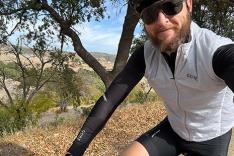
Time trials will always be the race of truth, where you cannot hide in a pack and your fitness and willingness to suffer is there for all to see. While fitness remains paramount, the smart racer will still be at an advantage if they can figure out the optimal and most efficient way of putting that power to the pedals and onto the road.
The Primacy of the TT
If there is one thing that the Tour de France teaches us each and every year, is that it never, ever hurts to be a good time trialist if you want to aim for the GC. In 2011, after an incredibly exciting 18 stages of roller-coaster action, the Tour essentially came down to a mano-a-mano battle between Andy Schleck and Cadel Evans, and we all know who went in as the stronger TT rider and how that ended up.
Realistically, in the last 30 years of the Tour, Marco Pantani in 1998 and Pedro Delgado in 1988 were the only winners who could not be counted as a time trial ace. That's not just true for the Grand Tours, but for the week-long tours like the Tour de Suisse, where Levi Leipheimer took enough time out of Damiano Cunego in the final stage time trial to take the GC by a mere 4 seconds.
And for amateur racers in weekend stage races (most often consisting of a road race, time trial, and criterium), guess which stage often creates the biggest time gaps and determines the winner? Looking through my own paltry stage racing palmares, my one noteworthy 3rd place on GC was built upon a 5th place in the time trial along with pack finishes in the two road stages.
More: 3 Elements of Faster Time Trialing
Brains over Pure Brawn
So it obviously pays to train yourself to be a strong time trial rider. Not only will it help in actual time trials, but so many parts of a race, namely an attack or a bridging effort, is just a time trial effort in disguise.
Secondly, another important component is the willingness to suffer and pain threshold to keep that high effort going. Thirdly, there is the technical ability to ride the best lines and to negotiate the course as economically as possible without wasting power or speed. Go back again to the 2011 Tour time trial to see Cadel flying over speed bumps while Andy pounded over them, and also the difference in cornering ability to preserve as much speed as possible.
A fourth critical component of time trialing is proper pacing strategy, and this has been a recurring theme in my writing. We've looked at it from the question of whether to go for an even versus negative (getting faster as the time trial progresses) or an "all-out" (hammer hard out of the gates and then hang on for dear life) strategy.
More: Pacing Strategy: Flat-Out or Even Steven?
There's another layer to pacing strategy, and that's in whether it is better to keep as constant a power as possible, or whether to ride a much more uneven power profile in the aim of keeping as constant a speed as possible. As anybody who has ridden with a power meter on an indoor trainer versus the real road knows, it's very hard to actually keep a constant power profile on the road, due to even slight changes in gradient or wind.
However, the basic question remains valid and important: Should I try to "attack" the hill with a higher power to try to keep my speed up, or should I try to keep a steady power?
- 1
- of
- 3








Discuss This Article